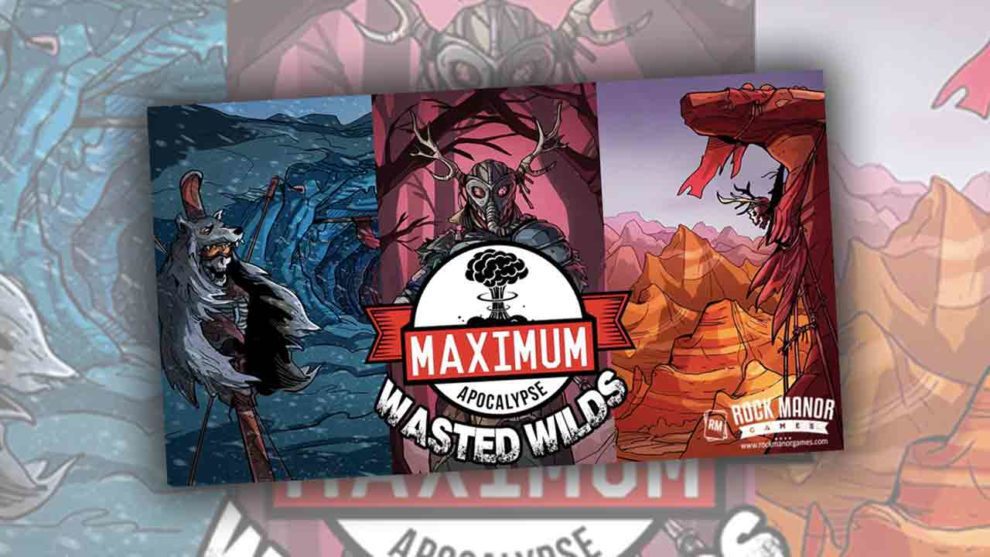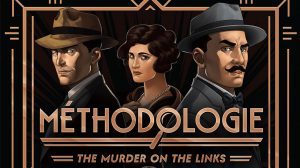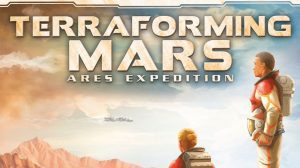Disclosure: Meeple Mountain received a free copy of this product in exchange for an honest, unbiased review. This review is not intended to be an endorsement.
As my friends and I were blazing through the first campaign of Maximum Apocalypse: Wasted Wilds, the most common phrase I heard was, “We’re screwed, aren’t we?” We faced off against sabertooth tigers, mammoths, bears, creatures from the underground, and other human tribes. Our survivors suffered a thousand deaths, such as being mauled by the local wildlife, getting shot by small squads of tribal members, or the environment slowly draining the life out of them.
If this sounds absurd, it should, since Maximum Apocalypse doesn’t pretend to be anything more than the wildest tour bus ride of everything related to the post-apocalypse genre. There isn’t any form of subtext about the violent nature of humanity and you won’t hear the words “War. War never changes.” It knows it’s dumb and rolls around in its filth like a happy pig, and there’s nothing wrong with that.
My admiration for the game does not end there. Maximum Apocalypse is surprisingly easy to get into. It does not attempt to impress the players with complicated rules or intricate systems. You select a character, take their deck, put your character mini on the Van tile, draw four cards, and you are ready to go.
You go ahead. Sneaking works for me.
Your objectives are based on the chosen mission, and I’ll be honest, they’re mostly just a game of ‘Go to the X, Y, and Z’! It might be as easy as trekking to a smoke signal to find a Nordic tribe kid and delivering them to the first Cavern tile you find. Or it could be more of a challenge, like starting out in a Police station with half of your starting inventory as if you got charged with a DUI.
You always surround yourself with facedown tiles that represent the map, no matter what scenario is used. Move onto the tile, flip it over, and some effect occurs, such as a free scavenge action or forcing you to draw a monster.
Each turn is as straightforward as the game’s objectives. You spawn monsters, advance the clock, then use four actions. These actions are ones you would expect from these types of games. Move your character, draw a card, use a card’s action, apply an instant effect, or scavenge a tile.
Even the combat itself does not conceal its simplicity. You use your actions to attack monsters with any weapons in your inventory, and the monsters attack when you have finished your four actions. Unlike most games of this genre, there are no monster miniatures here. Whenever you enter a tile with a monster token on it, or a monster spawns in a tile you are in, you draw a monster card. These cards are attached to you and form a line. When they activate, they resolve their attacks from left to right, and you can only remove them by either killing them or through an effect.
So far, I’ve only described the skeleton of the system. For this skeleton to move, it needs muscles and nerves, and that’s where the other systems come into play.
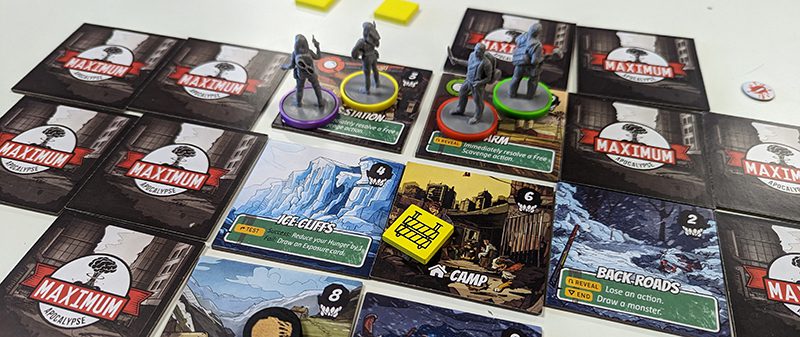
Baby, it’s cold outside
The first two you learn in the introductory scenario are the Clock and Exposure. After spawning monsters, the Clock will move forward, and if it reaches the Exposure event, you must check all players’ current locations. If any of them are in an “outdoor” tile, they will receive an Exposure card that hinders them in some way, such as taking damage at the end of every turn or reducing their inventory space. You don’t want this, trust me.
That isn’t the only event on the Clock that you should be concerned about. You have the Day event, which moves monster tokens around the map. The Night event puts some persistent or one-time effects that will last throughout the night. The most complicated one is the Tribe event, where they drift to their default hostility state.
Tribal Monsters are one of the most exciting aspects of Maximum Apocalypse: Wasted Wilds. Outside of the first scenario, you will encounter a particular tribe or three, as they come from the same deck as your typical hostile wildlife. Their behavior depends on their hostility level; if they are on the aggressive side, they will act like normal monsters. On the other side of the Hostility level, they will no longer attack. Instead, they will stay to help you attack monsters in your line or trade with you.
But how do you improve your relations? By sacrificing an item to Parlay, of course! This is genius in two ways. First, it means there’s an “economic sink” for your inventory, so items become more valuable because of scarcity. It also acts as a solution to “bad draws” since most of the game is card-based. Even if you scavenge a “useless item,” you can still use it to make sure the locals don’t kill you too quickly. It’s clever bits like this that I can’t help but admire.
Let the bodies hit the floor
As I sing praises for the various challenges that Maximum Apocalypse presents, its world-building impresses me just as much. The mechanisms and systems make sense for the game’s post-scarcity, nuclear-war-ravaged setting. Hunger is a real issue, acting like a ticking time bomb, and venturing outside for too long can lead to deadly consequences. With limited communication and resources, tribes form and defend themselves with the same tenacity as an American dad and his thermostat.
Maximum Apocalypse eliminates the need for an alpha player, as it cloaks its challenges in card draws, tile flips, and dice rolls. As a result, even the most experienced players cannot predict the outcome of their actions. Instead, the focus of the team’s discussion will center on risk management. I would say this is a dungeon crawler without a dungeon, a modern-day Heroquest. Even the characters used here follow the adventuring party archetype, such as damage dealer, tank, and support.
Unlike a large portion of the board game community, I do not mind randomization. My favorite genre is deckbuilding, which is based on the concept of a deck of cards. Maximum Apocalypse frames itself as a “Roguelike,” and while I can certainly see that, it does not justify some of the uneven sessions I have experienced.
Maximum Apocalypse doesn’t have a difficulty arc. It’s more of a heartbeat monitor bouncing up and down with no build-up. Sometimes the toughest part of a playthrough is at the beginning, with smooth sailing by the mid and end game point. Sometimes it’s just hard all the way through, no matter what.
The reasoning behind this is all the systems I’ve mentioned previously. Everything is determined by something random, like cards or dice. When a monster spawns, you roll dice, and if the number matches a tile, you place a monster token there or draw a monster if you are on that tile.
This means it’s quite possible that barely any monsters show up because the dice were in your favor or you get swarmed by them. Furthermore, some objectives require you to find random tiles first and spend an Action to complete an objective. This doesn’t sound bad, but let me tell you a tale of my first solo run.
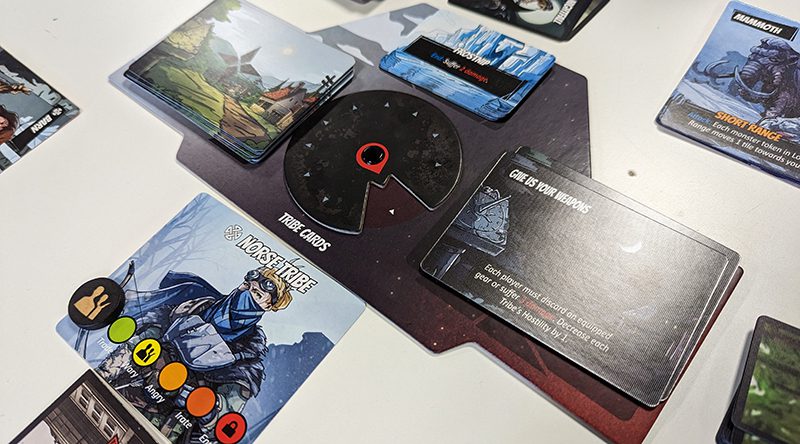
Solo adventures, without the wookie
It was one of the earlier missions in the first campaign. I have to go to a particular tile to find the source of a smoke signal, which is a Nordic tribe kid, and drag them to the Norse tribe’s lair which is the first Cavern tile revealed. I also need to grab one Fuel and deliver it to the Van.
You always have a monster at the start of the game and mine was a Bear, the meanest furry bastard from the Wilderness set of monsters. The good news is I had a Knife and a Butcher card, allowing me to kill the bear in two actions. Done.
I move to the next tile and it’s a Police Station. Because of its reveal effect, I get a free Scavenge action and I get a Fuel card. Cool, I’ve completed one of my objectives. Moving forward again, I reveal the Caverns and draw a Monster – an Elk, the least threatening enemy in the game. The next tile is Mountain, which grants me a free card draw on entry.
Finally, I reach the Gas Station and pick up the Nordic kid. The Elk damages me on my turn, so I run to the Cavern, drop the kid off, and make my way toward the Van – thankfully, no new monster appears thanks to some lucky dice rolls. Mission complete with the Elk getting a few bites in and I’m done in about four turns.
This felt less like going through a post-apocalypse world and more like taking a walk in the world’s most unregulated petting zoo. Now I wish I could say my grievances end there, but I can’t. I have to talk about the rulebook, because Mark from Meeple Mountain always complains about the rulebook.
A painful education
It does a decent job of going through the basics of the game’s flow. The first campaign teaches new players about the many systems like Tribes and Exposure cards throughout the missions. All of this sounds good except when it becomes technical with the keywords and terminologies.
An easy example I can cite is Immunity. One of my favorite characters in the game, the Beekeeper, has a Beekeeper’s hat that makes her immune to status effects like Exposure or Poison. Sounds great, so I would assume I don’t gain them. But what if I already have status effects? Because the rulebook does state in bold that Status effect damage cannot be reduced by cards. Is Immunity classified as reduction, or not? To answer such questions, I turn to the Glossary, except the Glossary does not mention Immunity at all.
As a result of this imprecise language, the first few sessions feel like you are interrogating the mechanics rather than enjoying the game. Some of the rule questions were answered on the BoardGameGeek forums, which shouldn’t be necessary for a game series that has been around since 2018.
Now one would assume with me expressing these issues that I dislike the game, except that’s not the case. As I’ve mentioned in the intro paragraph, I’ve gone through the first campaign, which is 10 sessions assuming you didn’t fail a single one. My criteria for reviewing games is 5 plays before I write down a single sentence.
Furthermore, the game has a second campaign with 12 missions, and I’ve already done the first 2 of that one. I’m not obligated to do this; I just want to do this because I’m enjoying the experience. My biggest frustration is I should love this game. Instead, I’m giving it the friend zone speech.
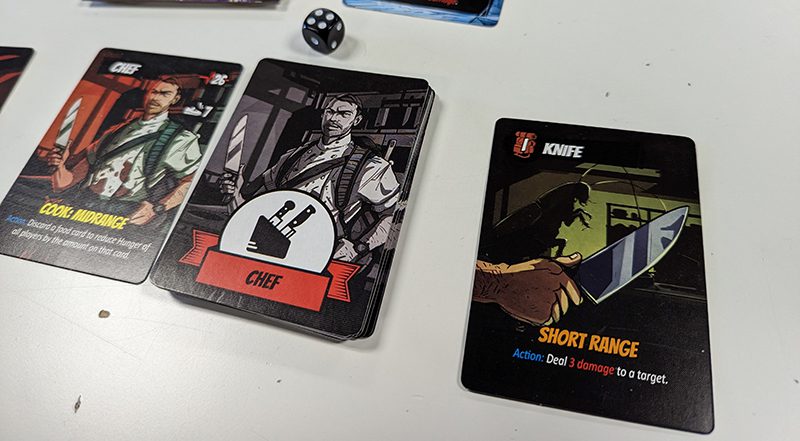
Murder without the jury
The good does outweigh the bad here. Despite the game’s lack of complexity, the monsters and tribes here present interesting challenges from the “Other Tribe” mirroring your team’s capabilities to the Plant monsters evolving each other to make themselves stronger.
The five characters are a blast to play; you don’t need a degree to get the hang of them. Just like in any co-op, each character has their own unique style – from the Beekeeper, the jack of all trades, to the Contractor, a walking flesh tank of tattoos. With your capabilities based on card draws, you have to stay on your toes and make tactical decisions with your team, so you can be sure you’ll get your brain working!
The tools you use in Maximum Apocalypse are so fun to abuse that plenty of engagement is generated. The stunning artwork immerses you into this ridiculous setting, making it the only game where you can debate if the Chef should feed the Rancid Onion to a Yeti so the Beekeeper can shove them into the Woodchipper and turn them into ice age sushi. Why does a Beekeeper have a woodchipper? Who cares! Not only does Maximum Apocalypse mock consistency, but it also makes memes out of it.
It’s also that lack of consistency that prevents this one from being great. Maximum Apocalypse doesn’t exist in a vacuum and with cooperative games like Testament or Pandemic that provide a challenging yet more structured experience, I can’t put this one on the highest of pedestals. It’s still an enjoyable game. You just need to put in some effort and tiptoe around its sharp edges to make it work. As for myself, I need to grab some fuel from the gas station. I’ve been enjoying that woodchipper a little too much.


